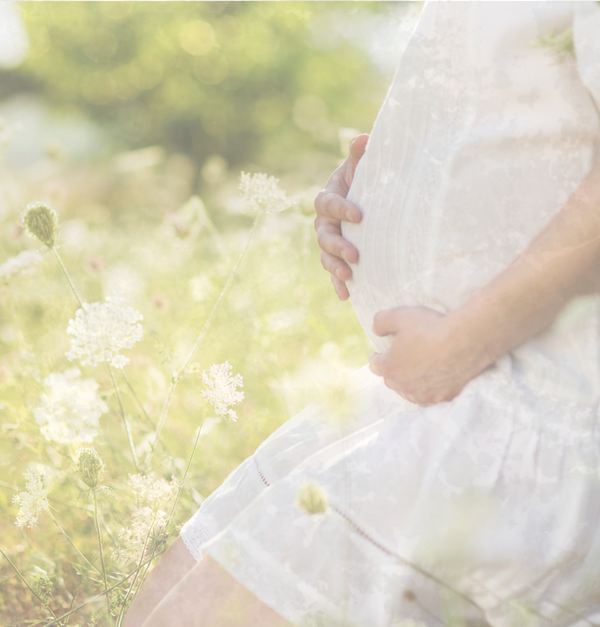The extraordinary pregnant body (part 1)

Have you ever wondered what’s really happening inside your body during pregnancy? While the external physical changes associated with pregnancy are well documented (hello baby bump!), internally your body and every organ is working together to make the miraculous business of growing a human possible.
While reading about the changes your body will undergo might seem daunting or at times scary, the emphasis here should be placed on how extraordinary the female body is.
Your body intrinsically knows how to support your baby's growth through each week of pregnancy - nourishing, loving and protecting your little miracle through each step of their journey.
The inside of your body during pregnancy is a magical, awe-inspiring place!
While the outside may look different from what it did before, internally every organ works together for optimal growth potential. Let’s take a closer look at some of these amazing changes.
Reproductive organ changes during pregnancy
Breast changes in the first trimester
Many women experience breast changes in early pregnancy – in fact, it’s often one of the first signs you’re pregnant. Surging hormones and a shift in breast structure mean your nipples and breasts may feel sensitive and tender from as early as three or four weeks. The nipples may become darker and the areolas (the area around the nipple) may grow larger. You may also notice that your breasts feel firmer and fuller. This is because the breast tissue is preparing for milk production.
Wondering how much breasts grow during pregnancy in total? By the time your milk comes in they’re likely to be almost one-and-half times bigger than before you became pregnant!
Breast changes in the second trimester
As your pregnancy progresses, you may find that the tenderness and swelling in your breasts doesn’t go away. In fact, it may intensify as your body continuesto prepare for breastfeeding.
From around week 15 of pregnancy, the new milk-producing cells in your breasts become active, and by around week 22 they may start producing milk. But don’t worry – most of this milk will be reabsorbed by your body.
Veins under your breasts may become more prominent and from around week 20 of pregnancy, small blood vessels (called capillaries)may appear and startshowing through patches on the skin of your breasts or areolae.
The areolas will continue to grow larger, and you may start to see bumps around the edges of your nipples. These wonderfully named ‘Montgomery’s tubercles’ produce a moisturising oil that helps protect against soreness and infection once you start breastfeeding. In fact, scientists believe the smell of this oil is similar to amniotic fluid and may help guide your newborn to your nipples after they are born.
Don’t strip these natural oils from your nipples by using harsh soap or rubbing them dry with a towel. Just use lukewarm water and pat them dry. And if anyone suggesting that you should ‘toughen’ your nipples by pinching or rubbing them, ignore them!
If you experience a sudden increase in breast size during pregnancy, your breasts may feel itchy and you might develop stretch marks. A gentle moisturiser can help soothe the itch. However, stretch marks are normally a matter of genetics and skin type; if you’re predisposed to them, there’s not much you can do to prevent them. The good news is they should fade and become much less noticeable over time.
Breast changes in the third trimester
Many women find that their breasts feel full, tingly and sensitive during the final weeks of pregnancy in the third trimester. These are all signs that your body is getting ready to make enough milk to feed your baby.
During this period you might notice a yellowish or brown discharge from one or both nipples. This first milk that you produce is called colostrum, which is full of antibodies that will help protect your newborn baby against infection. Colostrum is produced at the end of pregnancy and for several days after birth: many breastfeeding mothers have no idea that they are even producing breast milk until this time!
What happens to your breasts after birth
Around two to four days after your baby is born (sometimes longer if you’ve had a c-section or traumatic delivery), you’ll feel your breasts becoming much fuller and firmer as your milk comes in. Your breasts might become uncomfortable or even painful over this period, a condition called engorgement. Engorgement is a condition caused by a sudden increase in the amount of milk being produced.
Over time, your body will adjust to produce just the right amount for your baby’s needs. To help relieve pain and swelling during this period, you may want to try a breast massage or putting warm cabbage leaves inside each bra cup before nursing on that side.
You can also hand express or pump some milk to relieve the pressure and make it easier for your baby to latch on. Within a few days or weeks, your body will regulate its milk production and the engorgement should clear.
What happens to your breasts during lactation
During lactation, your breasts will undergo many changes in order to keep producing milk for your baby. The breast gland begins producing milk when oxytocin is released after delivery. Oxytocin causes muscle contractions that move the milk from the alveoli (milk-producing sacs) in breasts into ducts. This increased pressure created by the milk being moved from the alveoli into the ducts causes the release of more oxytocin, which starts the process all over again. This cycle will continue as long as your baby nurses.
The breasts will also increase in size during lactation because they are filled with fat and connective tissue. The nipples may become larger and darker and may even feel painful when the baby latches onto them. This is due to the high concentration of blood vessels under the breasts to provide oxygen to the milk. With all of the blood vessels, it may cause the nipple to feel more sensitive to touch and cold.
The skin of the breasts may become red, dry, and cracked; however this is usually temporary unless you are in an environment that contains too much moisture or heat.
After approximately six months of breastfeeding you will however notice that your breasts will start to become smaller. This is not usually cause for concern or an indication that you are producing less milk, but rather that you are starting to lose some of the fatty tissue in your breasts.
By the time your baby is 15 months old, you can expect your breasts to be the same volume they were before conception.
So, what can you do to make the changes in your breasts more comfortable during pregnancy and lactation?
There are a few things that you can try:
- Wear a good supportive bra that fits well (a sports bra is usually best because it will give extra support)
- Avoid wearing tight clothing that will squeeze or add pressure on the breasts
- Stay hydrated by drinking plenty of fluids
- Take a warm shower or bath to help relax the muscles and increase blood flow to the breasts
- Get regular breast massages from your partner or a pregnancy massage therapist to help increase blood flow and circulation
All of these changes can be frustrating and uncomfortable, but they are all a part of giving your baby the best start in life! By understanding what's happening to your breasts, you can better cope with the changes and ultimately be more comfortable breastfeeding your little one.
